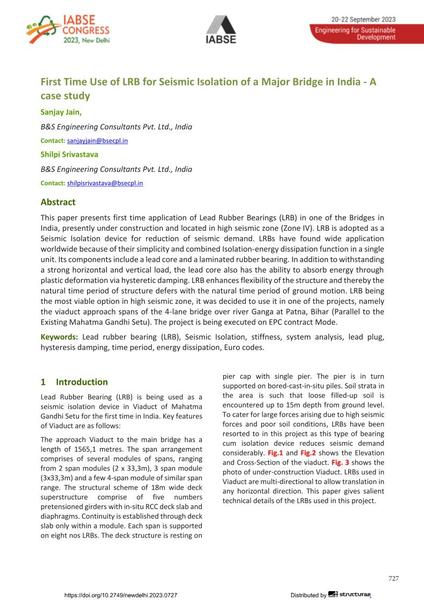First Time Use of LRB for Seismic Isolation of a Major Bridge in India - A case study

|
|
|||||||||||
Bibliographic Details
| Author(s): |
Sanjay Jain
(B&S Engineering Consultants Pvt. Ltd., India)
Shilpi Srivastava (B&S Engineering Consultants Pvt. Ltd., India) |
||||
|---|---|---|---|---|---|
| Medium: | conference paper | ||||
| Language(s): | English | ||||
| Conference: | IABSE Congress: Engineering for Sustainable Development, New Delhi, India, 20-22 September 2023 | ||||
| Published in: | IABSE Congress New Delhi 2023 | ||||
|
|||||
| Page(s): | 727-734 | ||||
| Total no. of pages: | 8 | ||||
| DOI: | 10.2749/newdelhi.2023.0727 | ||||
| Abstract: |
This paper presents first time application of Lead Rubber Bearings (LRB) in one of the Bridges in India, presently under construction and located in high seismic zone (Zone IV). LRB is adopted as a Seismic Isolation device for reduction of seismic demand. LRBs have found wide application worldwide because of their simplicity and combined Isolation-energy dissipation function in a single unit. Its components include a lead core and a laminated rubber bearing. In addition to withstanding a strong horizontal and vertical load, the lead core also has the ability to absorb energy through plastic deformation via hysteretic damping. LRB enhances flexibility of the structure and thereby the natural time period of structure defers with the natural time period of ground motion. LRB being the most viable option in high seismic zone, it was decided to use it in one of the projects, namely the viaduct approach spans of the 4-lane bridge over river Ganga at Patna, Bihar (Parallel to the Existing Mahatma Gandhi Setu). The project is being executed on EPC contract Mode. |
||||
| Keywords: |
seismic isolation energy dissipation stiffness system analysis time period Lead rubber bearing (LRB) lead plug hysteresis damping Euro codes
|
||||
